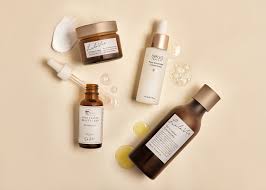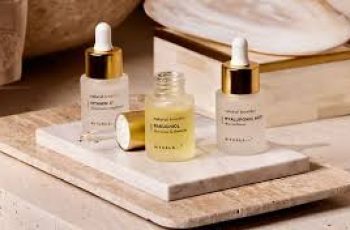
Do I Use Serum or Moisturiser First? A Complete Skincare Guide
If you’ve ever stood in front of your mirror, serum in one hand and moisturiser in the other, wondering which one goes first—you’re not alone.
It’s one of the most common skincare questions, even among beauty lovers.
With the explosion of powerful formulas and high-performance products, figuring out the correct skincare order can feel overwhelming.
But don’t worry—we’re breaking it down clearly and simply so you can maximise every drop of product in your routine.
So, Which Goes First—Serum or Moisturiser?
The answer is simple: Serum comes before moisturiser.
Why? Because serums are lightweight and packed with potent active ingredients. They’re designed to penetrate deeper into the skin, targeting issues like dullness, fine lines, pigmentation, and dehydration.
Moisturisers, on the other hand, are thicker in texture and are designed to hydrate the skin and create a barrier. That barrier helps seal in moisture—and all the ingredients from the serum.
Applying moisturiser first would block the serum from reaching the deeper layers of your skin, meaning you’re wasting your serum’s full potential.
How to Layer Serum and Moisturiser Correctly
Here’s how to do it right, step-by-step:
Cleanse: Start with a gentle cleanser to remove dirt, oil, and any makeup.
Exfoliate or Tone (optional): If using, apply your exfoliating toner or hydrating mist here.
Apply Serum: Use a few drops of your serum on slightly damp skin. Gently press it in with your fingertips.
Wait for Absorption: Allow about 1–5 minutes for the serum to fully absorb.
Apply Moisturiser: Follow up with a moisturiser to lock in hydration and strengthen your skin barrier.
SPF (AM only): Always finish with broad-spectrum SPF 30 or higher in your morning routine.
Why the Order Matters
Using products in the correct order ensures that each one performs at its best. Serums are made with smaller molecules, allowing them to reach deeper layers of the skin.
Moisturisers have larger molecules that form a barrier on the surface.
When you apply a serum after moisturiser, it won’t absorb properly and may just sit on the skin’s surface. This can reduce its effectiveness and lead to product pilling or layering issues.
How Long Should You Wait Between Serum and Moisturiser?
Ideally, give your serum about 1 to 5 minutes to fully sink into the skin before applying moisturiser.
If you apply moisturiser too soon, you might dilute the serum’s actives, especially if it hasn’t absorbed properly. Waiting allows the serum to penetrate effectively and prevents product buildup on the skin.
What If I Want to Use Two Serums?
You absolutely can use two serums in the same routine—but proceed with care.
Here’s what to keep in mind:
Use No More Than Two at a Time
Serums are potent. Using more than two at once can overwhelm your skin and increase the chance of irritation.
Layer Wisely
Apply water-based serums first, followed by oil-based serums or thicker treatments. Let each serum absorb before applying the next.
Watch for Ingredient Conflicts
Some ingredients don’t play well together. For example:
Vitamin C + Retinol: May cause irritation if used together.
AHAs + BHAs + Retinol: Risk of over-exfoliating or compromising your skin barrier.
Niacinamide + Vitamin C: Often debated, but some formulas are now stabilised to work together.
If unsure, consider using one serum in the morning and the other at night.
Morning vs Evening Skincare Routine (With Serum + Moisturiser)
Here are two example routines you can follow:
🌞 Morning Skincare Routine
Cleanser, Toner or exfoliating pad (optional), Brightening or antioxidant serum (e.g., Vitamin C), Eye cream, Lightweight moisturiser, Sunscreen (SPF 30+)
🌙 Evening Skincare Routine
Makeup remover (if needed), Gentle cleanser, Toner (AHA/BHA if used), Hydrating or repairing serum (e.g., hyaluronic acid, peptides, retinol), Eye cream, Night moisturiser or sleeping mask, Facial oil (optional)
Should You Apply Serum on Damp or Dry Skin?
For maximum absorption, apply serum to damp skin—especially if the formula includes humectants like hyaluronic acid, glycerin, or panthenol.
Damp skin is more permeable, meaning the serum will absorb faster and reach deeper layers of your skin. It also enhances hydration.
Serum vs Moisturiser: Which One Is Better?
This is like comparing apples and oranges—they serve different purposes, and both are essential in a complete skincare routine.
💧 Serums
Lightweight, fast-absorbing
Target specific concerns (acne, aging, pigmentation)
Contain concentrated actives
Penetrate deeper into the skin
🧴 Moisturisers
Thicker, protective
Lock in moisture and serums
Strengthen skin barrier
Prevent water loss and shield against irritants
If you’re serious about skincare, don’t choose one over the other—use both for best results.
Tips to Maximise the Effectiveness of Serum and Moisturiser
Less is more: Don’t overdo it with serums. A pea-sized amount is usually enough.
Always patch test: When introducing a new serum, test it on a small area first.
Keep skin hydrated: Serums work best on balanced, hydrated skin.
Stick to a routine: Consistency is key. Results build over time, not overnight.
Store products properly: Keep serums in a cool, dark place unless instructed otherwise (especially Vitamin C).
Should You Skip Moisturiser If You Use Two Serums?
No—serums don’t replace moisturisers. Even if you’re using two serums, you should still finish with a moisturiser.
Here’s why:
Moisturisers create a protective seal on top of your skin.
They lock in hydration from the serums.
They help maintain a healthy skin barrier, preventing irritation or water loss.
If your skin feels tight or dry after using serums alone, that’s a sign you need a moisturiser on top.
Final Verdict: Serum Before Moisturiser—Always
So, to settle the debate once and for all:
Use your serum first
Let it absorb for a few minutes
Follow with your moisturiser
This order helps maximize the benefits of each product, allowing the active ingredients to sink deep and do their job, while the moisturiser keeps everything sealed in and your barrier protected.
Whether your goal is to reduce fine lines, even skin tone, hydrate deeply, or protect from pollution, using your products in the correct order makes all the difference.


